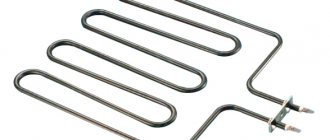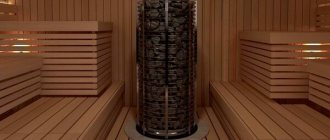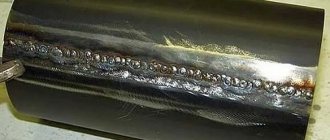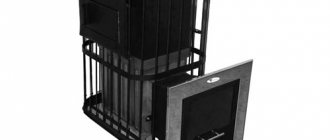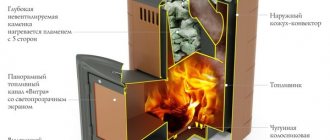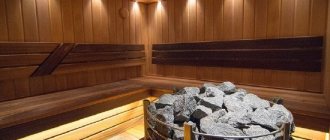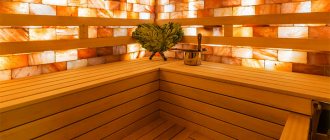A reliable electric stove for a sauna or bathhouse makes it easy to set up an effective home or commercial steam room. Models are presented on the market in different forms and price categories. You can choose either a simple, high-quality unit from a budget series, or a device of the latest version with a large number of additional options and bells and whistles.
To make it easier for you to navigate the wide range of electric furnaces presented by various manufacturers, we suggest that you familiarize yourself with the models that are most popular among buyers. In this article, we examined the characteristics of the 12 best electric furnaces, and also provided criteria for choosing an electric heater.
The rating includes products of domestic and foreign brands. The models are similar in operating principle, but differ markedly in power, size, installation method, cost and equipment. Knowing the strengths and weaknesses of each of the presented devices, it will be much easier to decide on the appropriate option.
Electric sauna stove: how to choose?
But it won’t be a matter of choice, you just need to get a sufficient understanding of what a sauna stove is, what types the market offers, and how to take into account the features of an existing steam room when purchasing.
We will try to provide comprehensive information on each of the points. And we’ll start, perhaps, by answering the question about what types of electric stoves there are:
By voltage: 220V or 380 volts
The voltage in a regular household electrical network is 220 volts. Therefore, most buyers are interested in their furnace operating from such a network. This would save them additional hassle and expense.
However, in practice, the voltage consumed is directly dependent on the power of the purchased unit. And the power, in turn, depends on the volume of the heated room .
It follows from this that the owner of a large family or family-guest sauna does not have to count on cutting costs - a large stove will need a 380-volt network. IMPORTANT! Typically, sauna stoves that consume 220 volts have a power of no more than 7 kW.
This is enough for a small and even medium-sized steam room. Electric heater SAWO MINI MN-23NB-Z. Photo by SAWO
You can bring 380 volts into a house or apartment - it’s not particularly difficult, you just need to take three instead of one phase. Difficulties arise with permits and with replacing wiring (it must be thicker than usual). Well, don’t forget that you will have to pay more for electricity bills, but this does not depend on the network itself, but on energy consumption.
By the way, you can easily install a three-phase 380 volt network in private homes - not everyone knows, but this issue is resolved at the request of the consumer.
Let's name several models of each subspecies:
Electric sauna heaters 220 volts - Helo CUP 45 ST, Sawo Mini MN-23 NB-Z, Harvia Vega Compact BC 23, Tylo Compact 2/4, Polytech-M PEN-2m.
Electric sauna heaters 380 volts - EOS 34 A, Harvia Virta HL 90, Tylo SD 20, Helo Seidankivi Seita 1052, Polytech "Christina" with evaporator ENU-18i.
Keep in mind! In the characteristics of some furnaces there is a mention of the possibility of connecting to both single-phase and three-phase networks - “220/380”.
Electric sauna stove Harvia Trendi KIP (220v and 380v)
With and without a steam generator
Another interesting point: do you need a stove with a steam generator in a sauna? After all, a sauna is called a “dry air bath” for a reason - there is little steam in it, the main “ingredient” is dry heat, which makes a person sweat (and convection is responsible for evaporation). How will he sweat if the humidity in the bathhouse increases?
Do you know, for example, why in Japan at 30 degrees the heat is considered unbearable, but in continental Asia even at 50 degrees people continue to calmly go to work? Because high humidity does not allow sweat to evaporate from the surface of the body, and it does not cool it (continental air is much drier than island air). The result is overheating, heart problems and other related ones.
IMPORTANT! You need to be careful with the steam generator in the sauna. Lower the temperature if you want more steam. And for an ordinary sauna, the steam produced by a regular heater, which is available in all electric models, is quite suitable.
However, sometimes a steam generator is necessary. For example, when we are talking about a heater that can operate in the “sauna” and “Russian bath” modes. Of course, it will be a surrogate, but it will be fast. The heater will almost instantly heat the bath to 60 degrees, and the steam generator will produce (if it can) fine steam.
BY THE WAY! Couples are different. There is a low-temperature one - you usually see it above pots and kettles. It is white and thick, and heavy on the body. There is superheated steam - it is almost invisible, it is light, and this is what your steam generator should be able to produce.
Steam generators are also different: built-in and separate. Here are some models.
Steam generator Helo HNS 34 T1
Separate:
- Sawo STP-90-C1/3 SST,
- Harvia HELIX HGX 2,
- Helo HNS 34 T1,
- Tylo Steam 2/4/6 VB,
- HygroMatik CompactLine C06-CDS,
- Sturm Etna 3 Pietra,
- EOS SteamTec Classic.
Built-in : all models with the word Combi in the name.
Electric stove for mini-sauna
A mini-sauna is a very small room (from 1.5 cubic meters), designed for one or two people steaming at the same time. Recently, it has become fashionable to arrange these right in city apartments.
Pleasant things are combined with useful things. A mini-sauna does not consume much electricity, and you can even make it yourself. The main thing is to take good care of thermal insulation.
What kind of stove can be used for a mini-sauna? Of course, also tiny. By the way, sometimes manufacturers put the word Mini or Compact in the name of such products. Here are examples of some models that you will find on the market:
Sawo - Mini and Mini-X series (see photo above). Harvia - Vega Compact, Delta, etc.
Harvia Delta D23 oven. Harvia Photos
By place of production: Finnish electric furnaces and all others
Who is considered the best manufacturer of sauna stoves? Of course, those who understand the intricacies of this bathhouse better than others. And in this regard, the Finns have practically no competitors - this is their national pride, which they are happy to export to the whole world. But exporting is always expensive.
Here are the names of companies that are popular in the market:
- Finland - Helo, Sawo, Harvia (a separate article is devoted to electric heaters from this manufacturer), Narvi.
- Sweden - Tylo.
- Germany - EOS.
- Russia - Inzhkomtsentr, Polytech, fuel and energy complex.
According to the material of electric heaters: tape and tubular
Well, of course, the ovens themselves are not belt or tubular. We are talking only about the design of the heating elements, which can be either in the form of tubes or in the form of a ceramic tape. Tubular shells are usually made of metal.
Tubular heater
IMPORTANT! Tubular electric heaters are quite fragile and easily fail. They can be damaged by stones that are placed too tightly (when heated, the stone expands), or simply by a random movement that bends the heating element at the base. See the article about the correct placement of stones in an electric heater.
Today, most electric heaters are equipped with tubular elements. The reason may also be a reduction in cost. But this is not the best option for the consumer. They are not as economical as tape ones. The latter also burn less oxygen!
Electric sauna stove, strip. Photo source
On a note! When calculating power, take into account that strip elements with equal power heat one and a half times the volume.
Useful video
Also watch a video about choosing electric stoves for a sauna from different points of view:
Operating principle of an electric heater
A traditional sauna stove contains three main components. This is the fuel compartment, chimney and heater. If firewood is used for heating, then it must be loaded into the stove in a timely manner, ignited, maintained, and the ash removed. It's a little easier with a gas oven. In this case, there is no need to bother with firewood and ash. However, the design still requires a separate combustion chamber and chimney.
In this aspect, electric furnaces have a clear advantage over wood and gas ones. There is no question of a chimney here at all; a combustion chamber is also not needed. Therefore, the heating elements can be located in the same compartment with the stones. This greatly simplifies the design and makes servicing the furnace much easier.
Small portable electric heaters have another advantage - mobility. If wood-burning stoves are attached to a chimney, then an electric one can be easily rearranged indoors or even moved to another bathhouse.
An electric heater with a steam generator has a slightly more complex design. When using it, there is no need to add water to the stones. The electric heater automatically regulates the steam supply. There is also functionality for temperature control. In this case, the user can choose a temperature regime that is convenient for themselves.
Let us note an important point. When choosing an electric heater with a steam generator, you need to pay attention to the characteristics of the steam it produces. For a Russian bath you definitely need fine, light steam. However, some models generate heavy steam, which is not suitable for a steam room.
Rating of electric sauna stoves
Well, we looked at a number of models based on various criteria. It would be a good idea to bring the information together to make it easier for the reader to make their choice. Therefore, we decided to invite users to take part in compiling a rating, this time of electric sauna stoves.
For our part, we have selected a list of the most popular manufacturers, because it is important to know who you can trust, and the parameters of the steam room and the needs of all consumers are different, it is not possible to take them all into account. But with our joint efforts we can easily help beginners with their choice.
Now is the time to move on to practical issues. Let's start with those that are asked by those sauna owners who have already decided to buy an electric heater. They need to know how to choose a stove with the right parameters.
Control
Electric heaters that vary in price have different sets of functions. Standard functionality includes the ability to adjust the temperature, automatically turn off after a certain period of time, as well as delayed start (usually up to 9 hours). Electric furnaces with a steam generator also provide humidity control.
The electric heater is controlled from the remote control. There are two main options here. The remote control can be built-in or remote. Built-in, together with all control keys and indicators, is located directly on the furnace body. Using the remote control, you can control the heater remotely.
Power calculation
It is easier to calculate the power of an electric stove than a wood stove. The manufacturer indicates the power in kilowatts in the passport. The consumer can only determine the volume of his steam room in order to get his bearings. But! There is a formal volume, and there is an adjusted volume after adding coefficients - for example, for surfaces without thermal insulation, for heating adjacent rooms in winter, etc.
So, tiles, glass, stone - you need to calculate their surface area, multiply by 1.2 and add to the formal volume.
the glass door to the steam room separately - just add an extra one and a half cubes to the existing numbers.
Then it’s simple: for one kilowatt of stove power - one cubic meter of steam room space, if the stove has heating elements , and one and a half cubic meters if there are tape heaters .
Design features of the electric heater
The main component of any electric heater is the heating elements. The most commonly used heating elements or tape heaters.
Heating elements for electric heaters
Most models on the market use heating elements. They are distinguished by their simplicity and unpretentiousness. A closed tube contains a metal spiral, which heats up when an electric current passes. Due to the simplicity of design and manufacture, heating elements are widely used in household appliances (heaters, kettles, washing machines).
Heating elements have also proven themselves well in heaters. But they have certain disadvantages, which become more pronounced when used open. So, in the process of laying stones, the heating element can be damaged. And if you fill it with water, it will completely fail. Therefore, you need to handle them quite carefully.
Tape heaters
The design of such heaters differs in that the spirals are laid inside a ceramic tape. Thanks to this, they are better protected and much more difficult to damage. The second advantage of strip heaters is their higher efficiency. With the same power, they are capable of heating a room 1.5 times larger in volume compared to heating elements. This is also facilitated by their design, which provides higher efficiency.
Tape heaters are more expensive than heating elements. Therefore, the cost of heaters equipped with them is usually higher. However, they are more likely to fall into the middle price category. There are models with heating elements that are noticeably more expensive.
Dimensions
The smaller the sauna, the more important the size of the stove becomes. Low-power heaters are usually very modest in size. As an example, we can mention the Harvia Compact stove - its width is 24.5-30 cm, depth 22 cm, height 54 cm. It weighs only 9 kg (without stones). Another model from the same company - Vega Compact - weighs even less: 7 kg and has dimensions: 28x29.5x50.5 cm.
IMPORTANT! Information on sizes is essential for selection, therefore it is always indicated in catalogs.
Yes, and one more interesting point : ovens of the same size (within the same line) can have different power. This allows the manufacturer to reduce production costs, and the consumer to choose a standard-sized heater for the volume of the steam room.
Further information will be useful to those who have already purchased a stove and need information on how to properly install and connect it.
Features of the construction of a bathhouse with an electric heater
When designing a bathhouse with an electric heater, special attention must be paid to the reliability of electrical networks and properly equipped grounding. If the room is large enough, then you definitely need to choose an electric oven powered by 380 volts. This means that you need to lay wiring with a wide cross-section of cores.
The electric heater in the steam room can be placed on the floor or wall. More powerful models require floor placement. In a small steam room, the heater can be mounted on the wall.
Another important point is room ventilation. Although there is no open fire, as in a traditional oven, oxygen will be vigorously consumed. Therefore, the issue of reliable ventilation of the steam room is very important for your health and safety.
Installing an electric stove in a sauna
Of course, an electric heater is not nearly as demanding as a wood-burning (and even more so a brick) stove. It does not need a foundation or a chimney ; many models can be mounted on the wall, and some can even be hung from the ceiling! However, some preparation is still necessary.
For your information! Did you know that some heater models can be installed directly into the bottom shelf? This significantly saves space, and the shelf is protected by a special flange made of steel or other material, which can be purchased along with the stove.
Where the heater will stand, it is better to lay out the floor with tiles or otherwise make it non-flammable (put a sheet of metal, for example). A suspended structure does not need this.
You will find the minimum distances to the main surfaces in the stove data sheet . Usually they are small, but they should be observed exactly or upward.
But if practically no questions arise regarding the installation of the furnace itself, then the same cannot be said about its connection.
Heater type - open and closed
A standard electric stove requires an open heater type. In this case, the stones are located between the heating elements and are not closed from above. This method of producing steam is the simplest, but has disadvantages. Stones located on top heat up less than those located below. The result is low quality steam.
In a closed heater, the stones heat up much better and more evenly. Thanks to this, such a stove produces good, finely dispersed steam, optimal for a Russian bath. But this has its own problems - to obtain high-quality steam, you need strong heating of a sufficiently large number of stones, which means high power of the electric furnace. But such an electric heater is not suitable for a small bathhouse.
Therefore, owners of small baths should consider the option of a steam generator.
Electric heaters with steam generators
The design of such electric furnaces involves autonomous steam generation. Due to the use of electricity for steam generation, the stones do not need to be heated as strongly as in traditional heaters. This allows you to save on power consumption.
There are steam generators that can be purchased and installed separately. If the steam generator is combined with a furnace in one housing, then such a design is usually called the term combi. Typically, models of electric heaters with a built-in steam generator have this word in their names.
Connecting an electric stove in a sauna
The fact is that each sauna owner must independently take care of grounding the purchased unit. If you are not particularly versed in electrics, then entrust the connection to professionals , it is worth it.
It was already mentioned above that electric heaters come with different voltages. For those that can be connected to a regular network, nothing needs to be changed in the wiring. But for those with a voltage of 380, you already need to stretch a cable of the appropriate quality and thickness .
So, grounding. It is better to make its circuit separate for the sauna, rather than using the circuit of the distribution panel . It's not that difficult - the Internet is full of information on how to make a ground loop yourself. It is preferable to conduct the core through cable channels.
In addition, we can recommend connecting the stove to the network not directly, but through a device that ensures that the electrical appliance is turned off if a short circuit occurs or the air in the steam room gets too hot. Such a device will not be needed if a differential circuit breaker with a leakage current of 30 mA is installed.
Most models provide a choice of a built-in or remote control panel. In the second case, you will have to take care of connecting the remote control. Typically, owners place it either at the door or in an adjacent room.
IMPORTANT! The remote control needs a circuit breaker in the distribution panel. Look at the stove data sheet to find out the current load. In accordance with it, the denomination of the machine is selected.
Electric furnace sensors allow you to monitor and control the heat. They also require installation, but all its points must be described in detail in the installation instructions for your stove.
IMPORTANT! Do not use intermediate connections, or extend or twist sensor wires.
A separate question is what wires can be used to connect the electric heater. If the oven is designed for 220 volts, then the wires will be three-wire, if for 380 - five-wire. An important issue is the sheath of such wires. The fact is that vinyl is in no way suitable for your purposes. It is correct to use rubber-insulated wiring that is not afraid of high temperatures.
*** So, we will consider that the short course for the future owner of an electric heater is completed. I wish you health and a pleasant stay in your own sauna!
Power supply type: 220 or 380 volts
For a small bathhouse, an electric heater with a 220 V power supply is suitable. You can connect and install such a stove yourself. Of course, it is better to call an electrician to check the wiring.
More powerful models are designed for a voltage of 380 V. It is better to call a specialist to connect them. Proper grounding is especially important here. There should be no phase imbalance, voltage drop, etc.
There are also stoves that can operate on both types of networks. If possible, it is better to connect them to 380 V.
Reviews
Despite the rather long history of using electric heaters, reviews about them are often exactly the opposite. A number of users believe that a real Russian bathhouse should be heated only by a wood stove. At the same time, it is argued that an electric heater is, in principle, unable to provide high-quality finely dispersed steam and the correct ratio of temperature and humidity.
There are also similar opinions among experts. True, it is usually noted that there are still models on the market that provide the conditions required for a steam room.
There is also an opinion that only with the help of an electric heater can you achieve precise parameters and maintain them offline. Therefore, such models are often chosen not only by private users, but by owners of commercial establishments.
As for ordinary users, many of them note the convenience of electric heaters, quick heating of the room and the absence of the need for complex maintenance.
Material of manufacture
Electric heaters are made from the following materials.
- Cast iron stoves. They have a lot of weight, but retain heat well.
- Enameled steel. A little in demand option.
- Stainless steel stoves. The most comfortable and current models, which are famous for their durability.
